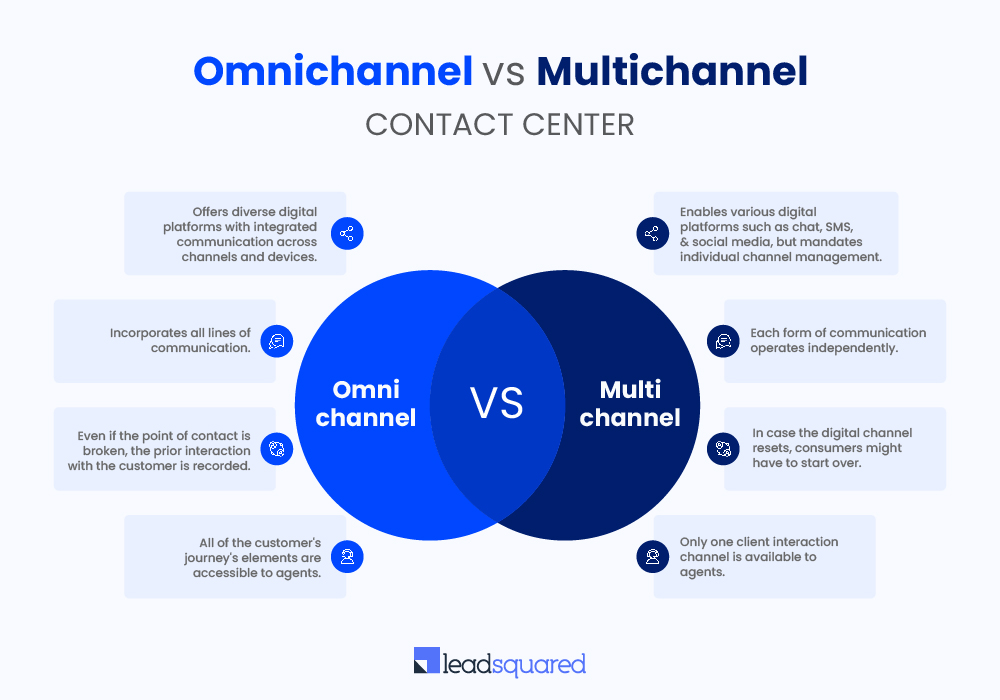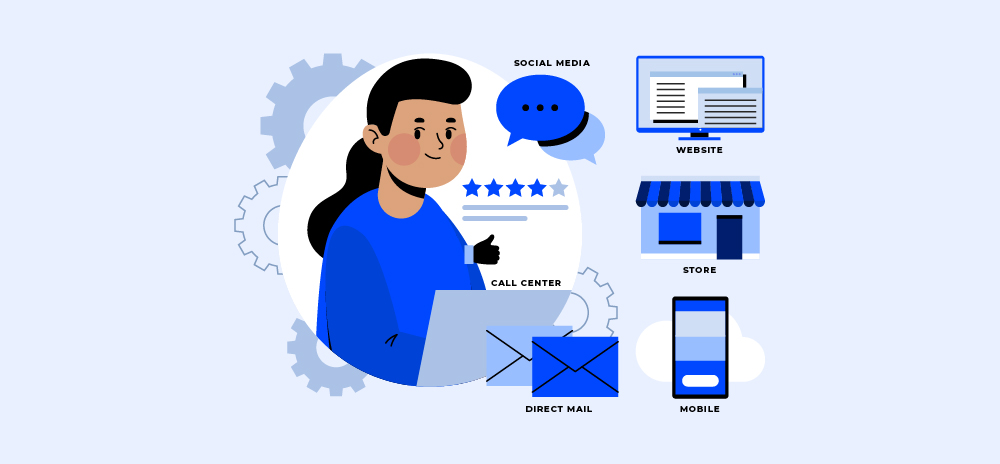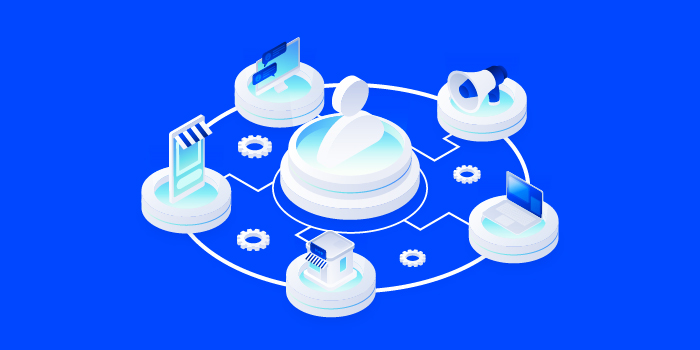Convenience reigns supreme in this tech-dependent world.
Customers now expect to be able to contact businesses via their preferred channels— whether its social media, phone, email, or live chat. And a powerful omnichannel contact center is the perfect solution to this challenge. It offers a seamless and effective customer service experience by integrating various communication channels into a unique platform.
In addition to providing customer service, an omnichannel contact center is an effective tool to build brand loyalty and deliver memorable customer experiences (CX). Nailing customer retention demands omnichannel finesse, especially with today’s elevated millennial standards.
An omnichannel contact center solution is now required to meet all important KPIs and metrics, whether the goal is to improve customer experience, increase customer satisfaction ratings, or to maximize customer engagement for your business.
This article covers everything you need to know about an omnichannel contact center, and the steps and tools you need to build one. First, let’s take a look at what an omnichannel contact center is.
What is an Omnichannel Contact Center?
An omnichannel contact center is a cloud contact center that unifies all customer service interactions from various platforms, including email, real-time chat, social media, phone, and more. It gives customers the freedom to contact businesses through any of their preferred platforms without a gap in communication, or having to explain their problems a million times.
On the contact center agent’s end, the omnichannel software allows them to communicate with customers from a single view and ensures that support is consistent across all platforms.
According to a survey conducted, the most preferred channels for omnichannel cloud contact centers are as follows:
- Live online chat functionality (82%)
- Email (76%)
- VoIP telephony (71%)
- Utilizing social networking (Facebook, Instagram, Twitter, etc.) (63%)
- Web-based conferences (50%)
- Communicating via SMS (48%)
- Faxing virtually (30%)
Let’s consider a real-world situation. You are a customer with a burning question about a product or service, and you just want to get it resolved quickly and smoothly. You might decide to call customer service, or maybe you prefer to send a message via web chat. But regardless of the method you choose, what you really want is to connect with someone who can help you out without any hassle.
A contact center agent can easily resolve customer problems across various platforms by employing the omnichannel approach, ensuring a seamless and positive experience for every customer.
Now, you might wonder, “Wait a minute, isn’t this just like multi-channel support?” There are, in fact, some significant distinctions between the two.
Omnichannel Contact Center Versus Multichannel Contact Center
On the surface level, a multichannel contact center resembles an omnichannel contact center as both allow customers to approach the business through a variety of channels. The difference is that the multichannel strategy maintains each channel of contact as a separate entity with its own team, system, and messaging. Whereas, omnichannel combines all of these platforms into a single, seamless system.

Businesses prefer the omnichannel strategy over multichannel for the following reasons:
- Agents can respond to inquiries more quickly and lessen consumer dissatisfaction owing to the centralization of all customer data.
- Customers don’t have to repeat information or retrace their steps when switching between contact channels.
- Developing the customer journey across numerous platforms enables the creation of more interesting, tailored experiences.
- Integrating new tech tools is simpler when all the channels and data is integrated in one place.
With an omnichannel strategy, all prior interactions and notes are accessible, regardless of the channel or the agent, because customer data is synchronized in real-time across all channels.
For instance, a customer contacts a product expert on your website using the live web chat feature when they have a question about a product. Based on this interaction, the client requests an online video demonstration with an expert.
The previous website chat transcript will be available to the product specialist who takes up the demo. As a result, they will be well-prepared for the video call, while being able to track the customer’s journey across channels. This was an example of how an omnichannel call center benefits customer support representatives, let’s take a look at the other areas it simplifies.
The Benefits of Using an Omnichannel Call Center
Omnichannel strategies not only benefit your customers but also make life simpler for your workforce. Some of the major advantages include:
- Improve personalization for customers
Approximately 55% of businesses claim that offering a personalized omnichannel customer experience is the most important factor in determining how well customer relationships are managed.
By offering automated customized text messages, emails, social media posts, and other communications, omnichannel contact centers make personalization simple. Particularly when it comes to customer service and product suggestions.
Your customers can be divided into different audiences (demographics, regions, or industries) based on information from previous interactions, and you can serve each of them with the content or product that is most likely to resonate with them. It even enables your sales team to deal with difficult personas.
Along with customer support, personalized omnichannel strategies boost marketing as well.
- Higher customer retention rates
Across omnichannel platforms, customers can interact on the channel of their choice, avoid repetition, cut down on hold times, and improve first-call resolution rates.
Additionally, omnichannel contact centers offer a consistent cross-platform user experience, which improves brand recognition and makes it simpler for consumers to get the assistance they desire immediately.
The first positive interaction sets the precedent for customers to return to your business, buy more, and eventually stick to your service/product improving customer retention rates.
- Enhanced perspective and understanding
The information from all of your active channels, including chatbots, live chat, email, and social media, is available on an omnichannel platform. You can obtain a comprehensive overview without integrating or exporting data from various tools, since automation simplifies it for you.
The integrated reports, channel-specific overviews, and functionality, in addition to the availability of customer reports and dashboards, give you a greater sense of overview and understanding. This enables managers and content center representatives to make wise choices quickly and effortlessly.
- Quicker response rates for customer support
According to reports, 82% of customers in the modern world expect a prompt answer to their customer support inquiries. A customer is more likely to interact with an agent on their first try and that agent will be the most qualified to assist with the support of omnichannel contact centers.
Better customer self-service functionalities are provided by advanced multi-level IVR capabilities, so in many cases, the client can resolve their own issues without ever talking to an agent. Additionally, this liberates agents for more urgent and complicated problems, boosting productivity levels.
- Optimizing the remote workforce
Work from home is an emerging norm, so any company communication tool should take this into account. Advanced omnichannel routing options increase the likelihood that an agent will always be accessible when a customer contacts you. Compatible mobile apps for Apple and Android smartphones and tablets allow agents to access customer history from any location at any time.
Call routing options transfer calls to the next available agent in the right department. Functionalities like remote call forwarding ensure that incoming calls are automatically routed from an agent’s phone system to their smartphone to their voicemail or any other specified call route.
Agents who work remotely can check project statuses, communicate with one another, and even edit files in real time. It can be done seamlessly due to team collaboration software’s integrations and APIs, which also enable remote workforce tracking.

A 5 Step Guide to Build an Effective Omnichannel Contact Center
Step 1: Implement a Cloud Contact Center Solution
To provide the best omnichannel client experience, you don’t need to completely rebuild your infrastructure. It is simple to handle data from applications across all support channels and to connect it with agents, customer relationship management teams, and other departments, like billing and sales, when your contact center is migrated to the cloud.
Additionally, when necessary, cloud contact centers can rapidly scale to accommodate changes in traffic.
Step 2: Choose your employees wisely
Building a successful Omnichannel Contact Center depends on hiring the proper people. Seek out agents who are proficient at managing a variety of platforms and can offer tailored customer experiences.
They should be highly skilled in problem-solving, multitasking, and conversation. Managers can regularly provide opportunities for learning and growth to keep them up to speed on the latest technology and customer service developments.
Step 3: Learn About your customer’s journey
Understanding your customer’s journey is crucial before you start developing an Omnichannel Contact Center. Determine the channels and preferences your customers use to interact with your company.
Utilize surveys, analytics, and client feedback to learn about the needs and expectations of your customers. This will assist you in creating an Omnichannel Contact Center that is focused on the requirements of the customer.
Step 4: Focus specifically on social media
The impact when it comes to social media in an omnichannel contact center is especially high. This is so because social media platforms magnify the effect of good or bad customer care. With more than half of the customers turning to social media sites like Facebook, Instagram, and Twitter for assistance, social media customer service is expanding.
Social media, however, is also the platform where consumers are most likely to be forgotten. According to studies, the average response rate across all industries is less than 25% on social media, even though 79% of customers anticipate brands to reply within a day of their inquiry.
Step 5: Consistently observe and optimize
It’s crucial to constantly watch and improve an omnichannel contact center because it’s a dynamic process, technology, and customer preferences are constantly evolving. As more channels are introduced, some may become unnecessary and can be dropped from the blend, saving time for agents and boosting productivity—possibly even enhancing customer service.
As you introduce more channels, think about how they might interact and change how consumers utilize your channels. To remain current with the most recent trends, regularly update your technology and procedures. By doing this, you will be able to offer a seamless customer experience and stand out from the rest.
Tools Required to Build an Effective Omnichannel Contact Center
You will require a number of tools to create an effective omnichannel contact center, including:
- Contact Center Software
An omnichannel contact center’s primary component is a contact center software that enables representatives to control customer interactions across all communication platforms. This software should have the functionality to direct queries to the appropriate agent, connect with other systems, and offer analytics and reporting features.
- Voice over IP (VoIP) Technology
Making and receiving conversations via phone over the internet requires the use of voice-over IP (VoIP) technology. Agents should be able to place and receive conversations, route them, and record them using a VoIP system, which should be in an efficient omnichannel contact center. Using crystal-clear audio quality and simple call routing, MyOperator Voice over IP (VoIP) Technology powers client interactions across a variety of channels in an omnichannel contact center.
- Chatbots
Chatbots are software applications that use artificial intelligence to interact with consumers via chat. Chatbots that can manage basic questions should be available in an omnichannel contact center, enabling agents to work on challenging issues.
- Customer Relationship Management (CRM)
The management of client information and interactions requires the use of a CRM system. To give agents a comprehensive picture of the customer, an omnichannel contact center needs a CRM system that integrates with the contact center software. Such integration enables businesses to provide personalized and efficient customer service by giving agents quick access to relevant customer information and history.
With advanced automation, insightful analytics, and clever lead management, LeadSquared CRM is the most potent tool in an omnichannel contact center’s toolkit for streamlining customer interaction and boosting conversions. You can get in touch with our team to understand it’s features and functionalities better.
- Data analytics tools
Managers should be able to monitor and examine customer interactions across all channels with the help of data analytics tools in an efficient omnichannel contact center. The contact center can enhance its performance over time by using these tools, which can offer insights into customer behavior, preferences, and issues.
- Knowledge Management System
A knowledge management system is a tool that enables companies to keep and handle the content that can be applied to customer support. A knowledge management system should be available in an omnichannel contact center so that employees can easily access data that will improve the speed and effectiveness with which they respond to customer queries.
- Social Media Management Tools
Customers frequently use social media platforms like Facebook, Twitter, and Instagram to interact with businesses. Agents should be able to track and respond to social media inquiries with the help of social media management tools in an omnichannel contact center.
In conclusion
The evolving requirements of the modern customer can be met with the assistance of an omnichannel contact center. Whether they prefer social media, emails, chatbots, or conventional phone calls, you will be able to manage client interactions on all of their preferred channels.
Keep in mind that as technology and customer requirements advance, there is always room for progress. Analyze the data you collect after you start receiving customer insights, then adjust your omnichannel strategy as required.
FAQs
Q1. What is an omnichannel contact center?
A customer service strategy known as an “omnichannel contact center” enables customers to communicate with a company via a variety of channels, including chat, email, phone, social media, and much more.
Q2. What kind of technology does an omnichannel contact center require?
An omnichannel contact center needs a unified communication system, customer relationship management software, and analytics tools to monitor and improve the customer experience.
Q3. What are some best practices for managing an omnichannel contact center?
Best practices include defining clear goals and metrics, providing agents with training and support, creating effective workflows, monitoring performance, and regularly collecting and analyzing customer feedback using a CRM such as LeadSquared.
Q4. How do I get started with building an omnichannel contact center for my business?
A call management software and a CRM are the two essential tools that you need to build an omnichannel contact center. You can get started by requesting for a free demo to implement a completely integrated contact center and CRM solution!








![30 Must-Know Sales Statistics for 2024 [Expert Insights Included!] 3 Sales Statistics for 2023](https://www.leadsquared.com/wp-content/uploads/2023/03/Sales-Statistics-for-2023-80x80.png)
